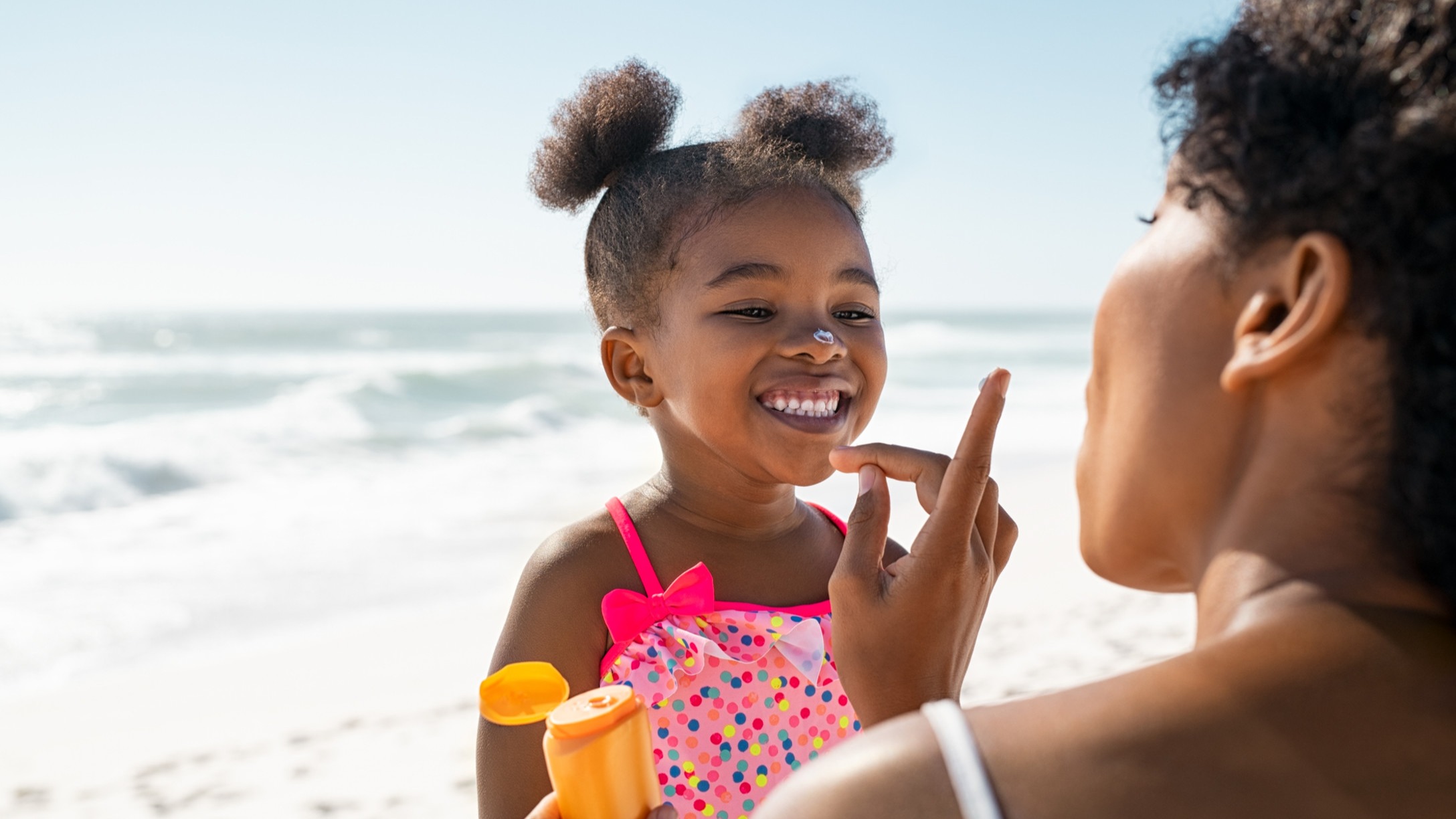
Summer is here! And no one wants to be cooped up indoors while there’s plenty of fun in the sun to be had. That said, there are some summer hazards parents should be aware of. Things like pesky insects, sunburns, and dehydration can really put a damper on the summer fun, especially when kids — and pets — are involved.
No kid wants to spend their summer itching and burning from head-to-toe, or worse, be sidelined with an injury. So before you head out to the beach, your local pool or park, the zoo or the amusement park, check out these essential summer safety tips for the whole family, to ensure that everyone in your crew stays healthy and safe all summer long.
1. Sunscreen, Sunscreen, Sunscreen
Obviously, any discussion about summertime fun begins with a healthy dose of sunscreen advice. Protect your kids’ skin — and your own — from sunburns, hyperpigmentation, premature aging, and future skin cancers with any FDA-approved sunscreen. The American Association of Dermatologists recommends wearing a minimum of SPF 30, and choosing products that are water-resistant and labeled “broad spectrum,” as these will protect against both harmful UVA and UVB rays. Sunscreen should be worn every single day, even if it is cloudy.
Also, apply more sunscreen than you think you should. For the face, neck, and ears, you’ll want to apply at least a 1/4 teaspoon, or two lines of the product down your index and ring ringer, as demonstrated by cosmetic chemist Dr. Michelle Wong above. For the body, the AAD recommends applying a “shot glass” amount of sunscreen for an average adult body, and to scale down proportionally for children.
Be sure to reapply sunscreen to yourself and your kids every two hours during continuous sun exposure. Yes, it can seem tedious, but this will maximize protection. For infants, the AAD advises parents to keep babies under 6 months out of the sun entirely; they should be kept in the shade, and wear sun-protective clothing, including a wide-brimmed hat and sunglasses.
This applies to every skin tone, every race and ethnicity, and every age group. It is a persistent myth that melanated skin tones aren’t damaged by the sun. Yes, darker skin is more resistant to sun-caused wrinkles and sunburns, but anyone, regardless of skin tone, can develop skin cancer. The Skin Cancer Foundation reports that 1 in 5 Americans will develop skin cancer by age 70. And due to this myth, when people of color are diagnosed with skin cancer, it is often discovered in later stages, and ends up being more difficult to treat, and more deadly.
As the planet warms, our kids’ skin will be exposed to more radiation from the sun than in previous generations. The International Journal of Women’s Dermatology estimates that global skin cancer rates will rise by 11% by the year 2050. That’s a shocking statistic, but instilling good sunscreen habits in your kids now, may save their skin when they are older.
Not All Sunscreens Are Greasy!
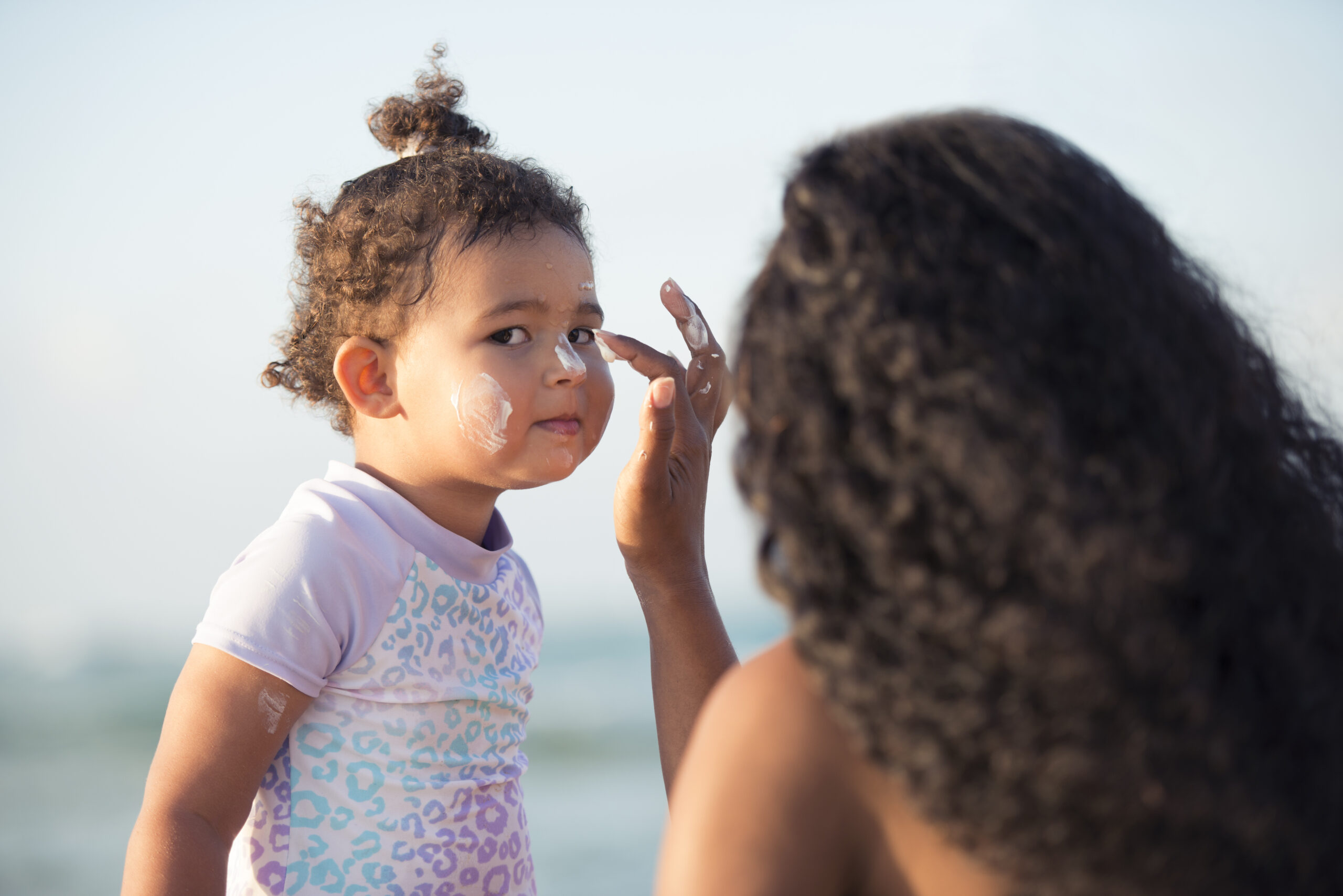
People who don’t wear sunscreen often complain that they don’t like the product texture. Yes, many sunscreens can feel greasy, chalky or leave a white cast on darker skin tones, while some just aren’t pleasant to wear every day. Luckily, there’s been a lot of advancement in SPF technology, and there are now lots of brands creating sunscreens that are as cosmetically elegant as your daily moisturizer.
You can also check out our SPF recommendations here for sunscreens that are effective and comfortable to wear. Remember: don’t rely on skin care creams and makeup with built-in SPF for your sun protection. You should apply a layer of dedicated SPF to yourself and your kids every single day.
Safety Never Looked Better in a Pair of Shades

It’s baby’s first trip to the beach, and you can’t figure out why the little one is so fussy. Her diaper is clean, she was just fed, and you can’t see any uncomfy rashes. Well, she might just need a pair of sunglasses! They’re functional and are the coolest way to stay safe in the sun.
Sunglasses help us see in bright light. And they’re especially important for infants — babies’ vision is still developing, and they lack color differentiation, depth perception and can’t make out details. Infants are often born with less pigment in their eyes. In other words, they may have lighter-colored eyes shortly after they’re born, and the color may darken as they get older. Lighter eyes means increased sensitivity to sunlight. Keep their extra-sensitive eyes safe from sun exposure with a pair of baby-sized sunnies.
Like SPF, sunglasses also protect eyes from harmful UVA/UVB rays. While most sunscreens are safe for the eye area, they may cause irritation and tearing, and kids aren’t going to love it. Plus, sunscreen on the skin won’t protect your eyes’ lenses, retinas, and corneas. Wearing sunglasses regularly can help prevent macular degeneration and cataracts later in life, ophthalmologist Dr. Lisa Park explained in an interview with GQ, so the earlier kids get into the habit, the better off their eye health will be in the long run.
2. Never Leave Kids or Pets Alone in a Car
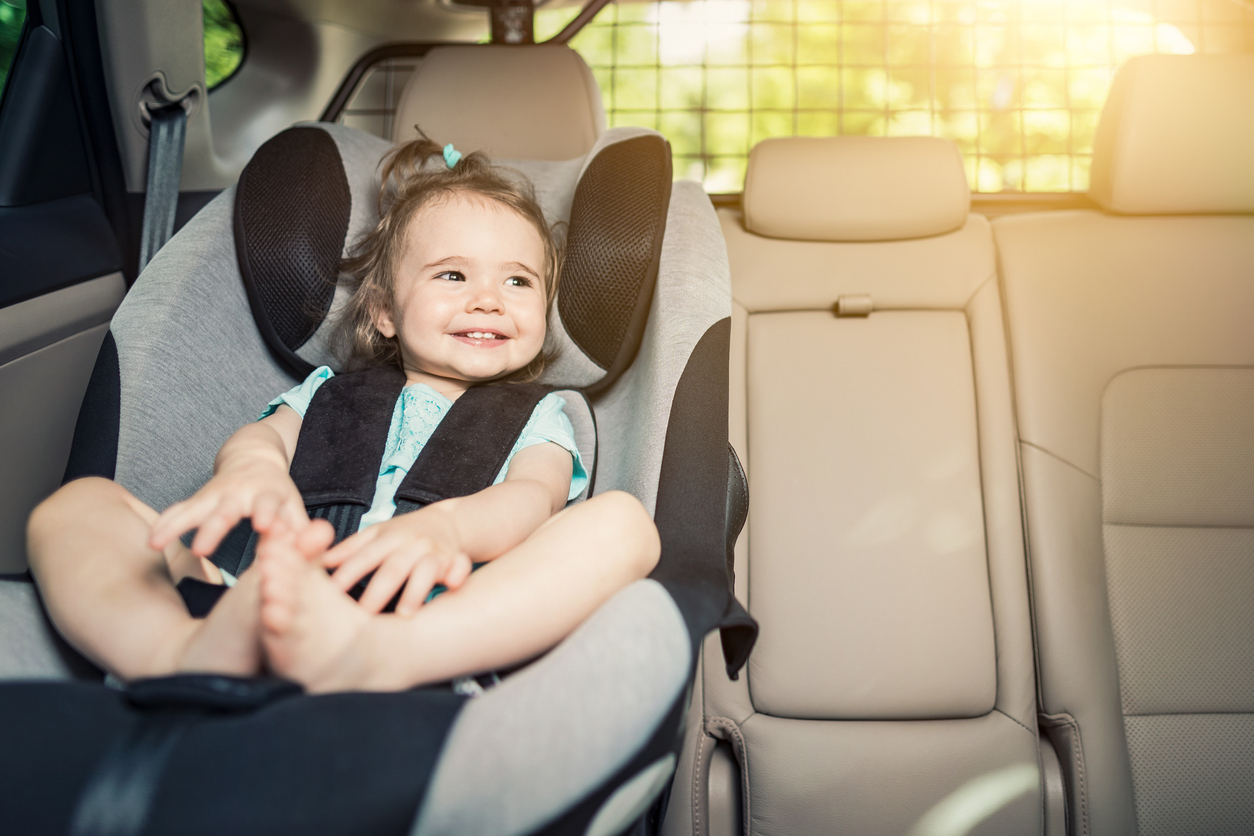
It’s common sense, but unfortunately, it keeps happening year after year. Every summer, there’s another heartbreaking news story about kids in hot cars dying from hyperthermia. We can’t stress it enough: Do not, under any circumstances, leave kids, pets or anyone else alone in a car for any period of time, not even with the window cracked or air conditioning running.
Even if the weather isn’t too hot that day, during cooler summer evenings or if you are just “running inside” for a minute. It is absolutely not worth the risk, and it is illegal in most places.
It's Simple Physics

Maybe you are just “running inside” for literally five minutes. But let’s go back to high school physics class to understand why this isn’t safe.
High-frequency light waves go through the car’s glass windows, those waves are then bounced through the car’s interior and released as low-frequency heat energy, and heat can’t escape. The car essentially becomes an oven.
In minutes, the temperature will increase dramatically, leading to dangerous conditions. When exiting the car, triple-check to make sure no kids or pets are left inside. It could save lives.
Get Involved if You See It

What should you do if you see a a child and/or pet alone in a car on a hot day? First, don’t feel uncomfortable about intruding on someone else’s “business.” By getting involved, you could be saving a life. The Department of Transportation advises folks to call 911 immediately if the child appears to be in distress. Make any and every attempt to remove the child from the car.
If the child is responsive and does not seem to be in distress, you can “stay with the child until help arrives,” suggests the DOT. If you’re going to fetch help or attempt to locate the child’s guardians, remember that hyperthermia can occur in minutes, so don’t leave them unsupervised if at all possible.
3. Practice Safety with Air Conditioning Units

Ahh, air conditioning, a summertime necessity. But don’t forget to keep safety in mind when blasting the cool air.
Discourage kids from playing near window air conditioning units. Make sure the units are anchored into the wall or windowsill to prevent them from falling and injuring someone below. Check the filter frequently to keep the unit energy-efficient, and make sure power plugs and cables aren’t frayed to avoid electrocution and fires.
Most importantly, be smart about where you place the units. Don’t let air conditioning units obstruct fire escapes or any other kind of egress, in case of an emergency. Some adults — let alone children — can’t lift up an air conditioning unit by themselves to access the outside, so make sure escape routes aren’t blocked.
4. Keep Kids Hydrated with Actual Water
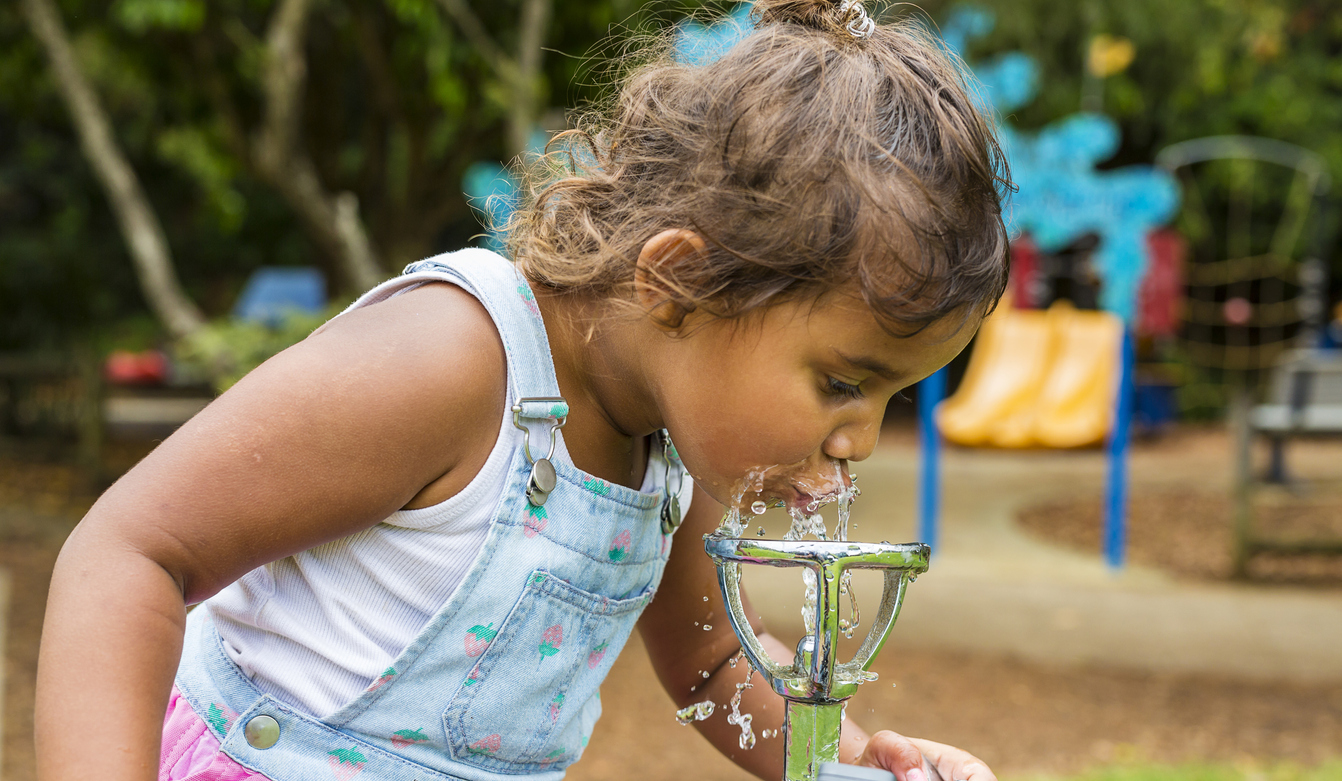
Kids seem to have nonstop energy, and will often play outside for as long as you’ll let them. But it’s important to make sure children stay hydrated when they’re out in hot weather. Dehydration can creep up slowly and the symptoms may not be noticeable at first.
Obviously, making sure kids drink plenty of water is the best way to keep them hydrated. Water is best since sugary drinks don’t have enough sodium and electrolytes to keep the body hydrated, and caffeine has diuretic properties. While studies have shown that seltzers and carbonated drinks do not cause dehydration, they too should only be consumed in moderation, since the fizz can make us feel too bloated to keep drinking adequate amounts.
When you’re at the park, always check your area’s lead water pipe testing policies to ensure that public fountains are safe. Don’t let kids drink water from ponds or streams. And pack more water than you think you’ll need for hot weather outings. Trust us, it’ll be gone in no time.
Know the Symptoms of Heat-Related Illness
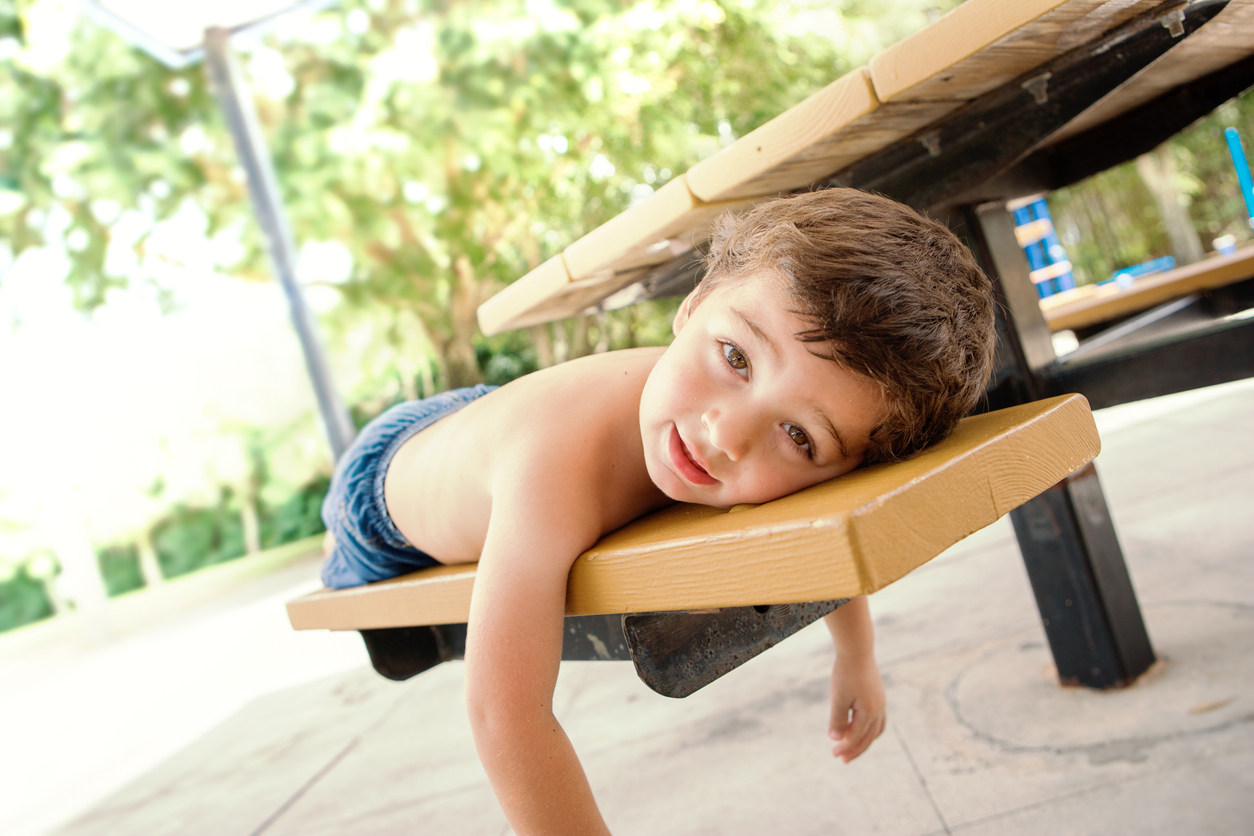
A few medical conditions are specific to summer weather. Heat-related illnesses manifest with a variety of symptoms, ranging from mild heat cramps to heat stroke, which is an emergency condition. Johns Hopkins Medicine warns that children and teens are at a distinct risk for HRIs because they “adjust more slowly than adults do to changes in environmental heat.”
Emergency symptoms to watch out for include: fever, nausea and vomiting, headache, lethargy, and changes in mental status, such as agitation or confusion. Call 911 immediately if anyone is exhibiting these symptoms, and attempt to cool the person down until EMS arrives. Johns Hopkins suggests the following first aid: “Remove excess clothing and drench skin with cool water; fan skin … Move to a cool place and rest.”
Unfortunately, the rates of heat-related illnesses are only going to increase as the planet warms. The Environmental Protection Agency notes that “extreme heat events (heat waves) are expected to become more frequent and more intense in the future … As a result, the risk of heat-related illness is expected to increase.” Knowing the symptoms of HRIs now could keep you safe in the years to come.
5. Stay Safe Around the Pool
We could write a dozen articles about water safety alone, but let’s go over the basics.
Always supervise kids at the pool. If they know how to swim, don’t assume that will prevent all risk of drowning. Don’t swim at public pools and beaches unless there is a lifeguard on duty. Teach kids to walk carefully around pool ledges, and keep pool cleaning chemicals away from kids and pets. Provide lots of flotation devices both in the water and on the deck, but remember that they are not substitutes for active pool monitoring.
Most importantly, always secure home pool access. If your pool is in the backyard, keep back doors and pet doors locked. Build a fence or other barrier system so the pool is completely inaccessible unless it is being supervised.
Water safety really comes down to supervision. You can’t have too much of an eye on little ones near the water.
Not All Dogs Know How To Swim
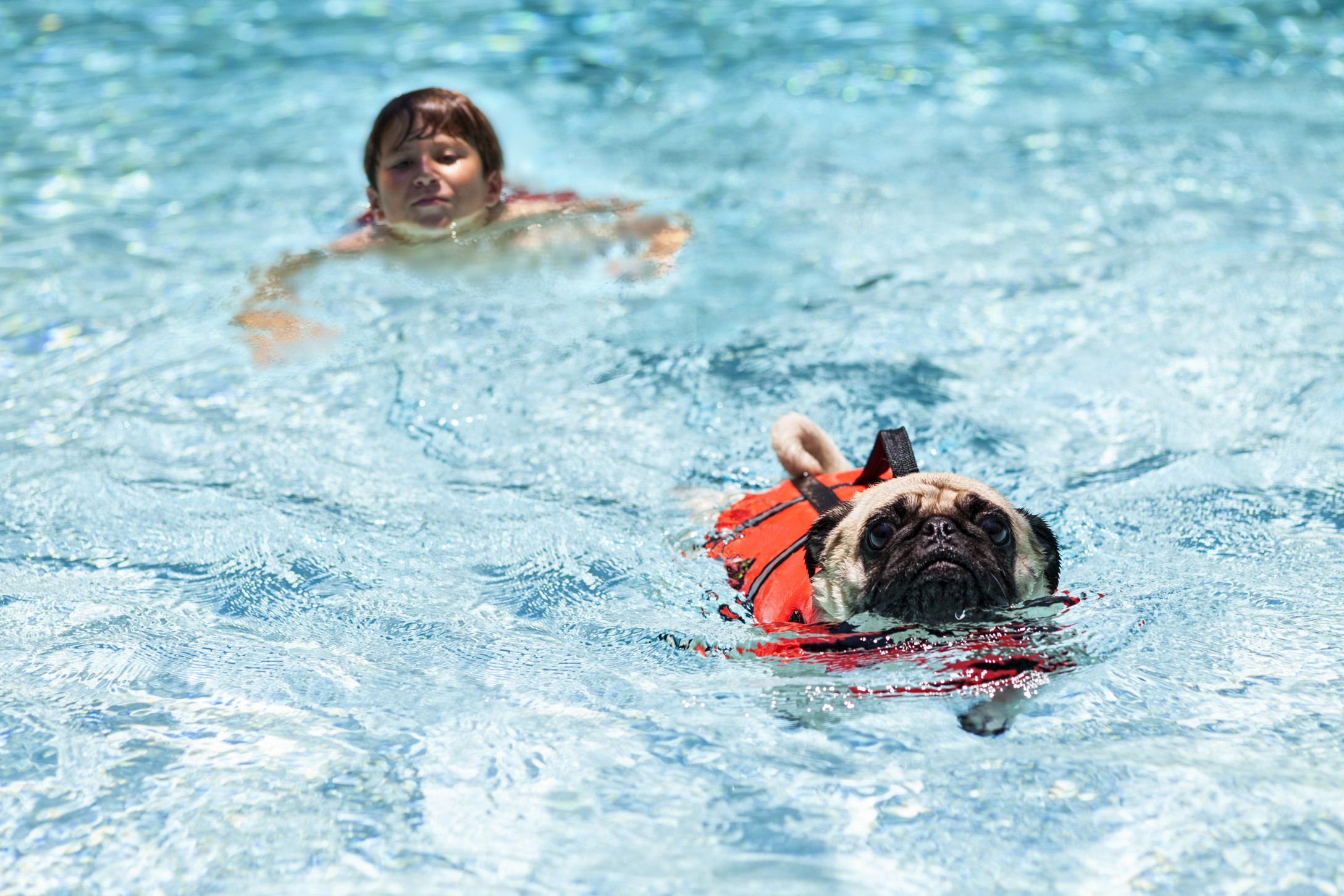
What kid doesn’t love doing cannonballs into the pool with their best furry friend? It’s important to make sure all members of the household are practicing pool safety for pets, so make sure your kids are familiar with pet pool safety before you let them near the water with animals.
The American Kennel Club says it is a myth that all dogs instinctively know how to swim. Some breeds, like French and English bulldogs, are unable to swim due to their body shape, while some rescue dogs may never have been exposed to the water, and may be too panicked for their paddling instincts to kick in during an emergency. Don’t assume that dogs are naturally safe around pools.
Teach kids not to bring dogs into the water. Let the dog approach the water on its own, and keep it away from the deep end. Don’t let kids roughhouse or “ride” bigger dogs in the water, and never, ever let kids and pets play in the pool unsupervised. Do not keep the pet leashed in the water. The leash can easily get stuck in the pool filtration system or on a ledge. Pet owners should also consider adding safety ramps to their pools, since dogs can’t climb ladders.
To keep dogs extra-safe, deck them out in a flotation vest — it’s especially necessary for stockier, short-legged breeds like dachshunds and basset hounds, as well as toy breeds that aren’t fond of swimming. Pay extremely close attention to brachycephalic dogs — breeds like pugs and boxers — which have flattened snouts, as they can struggle to breathe in the water. Keep them confined to shallow wading areas as much as possible.
Get Those Summer Swimming Lessons In!
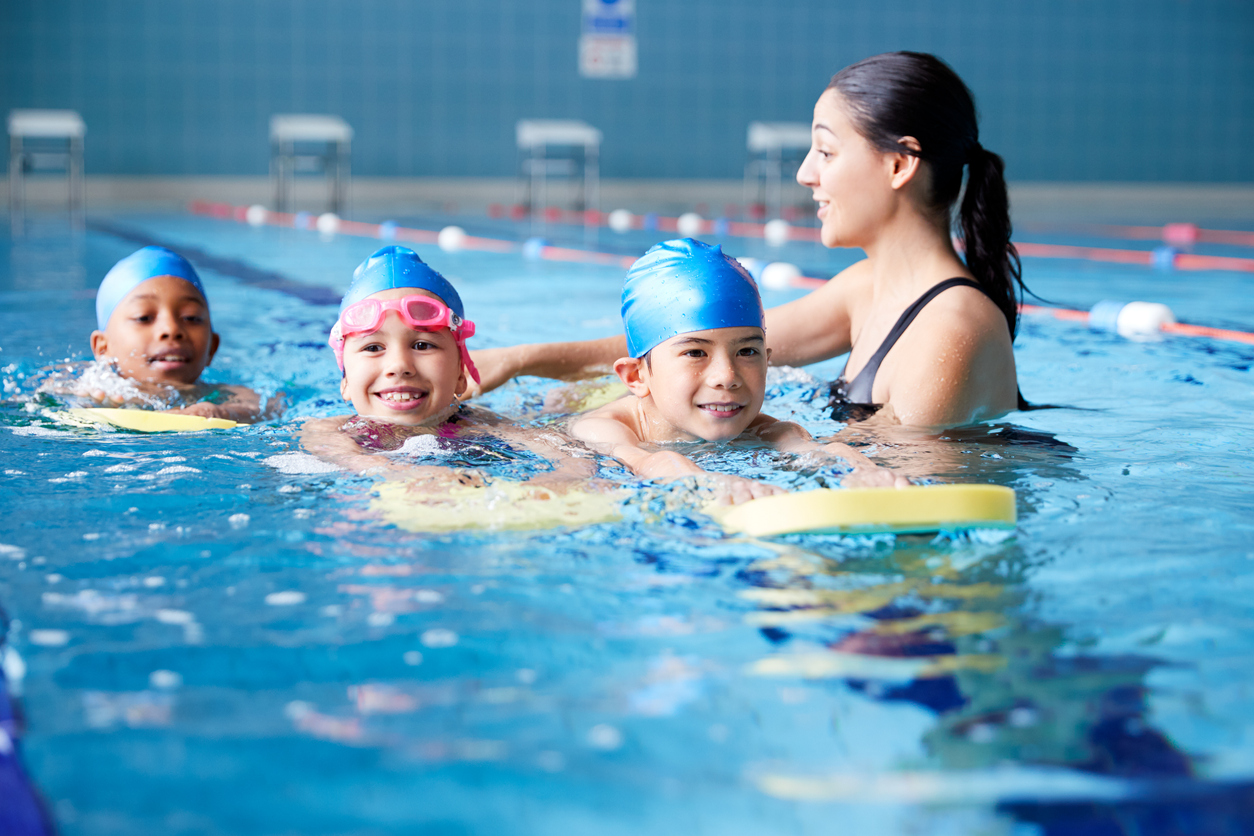
Teach able-bodied kids to swim as soon as you can, even if you don’t live in a coastal area. Many public pools, community centers, and local YMCAs provide group swimming classes for kids as young as 3. Learning how to swim saves lives, not just for the swimmer, but for anyone else who may need help in a water emergency.
It’s a basic skill on par with administering CPR, carrying Narcan (naloxone), and learning choking safety.
6. Stay Summer Safe at the Beach
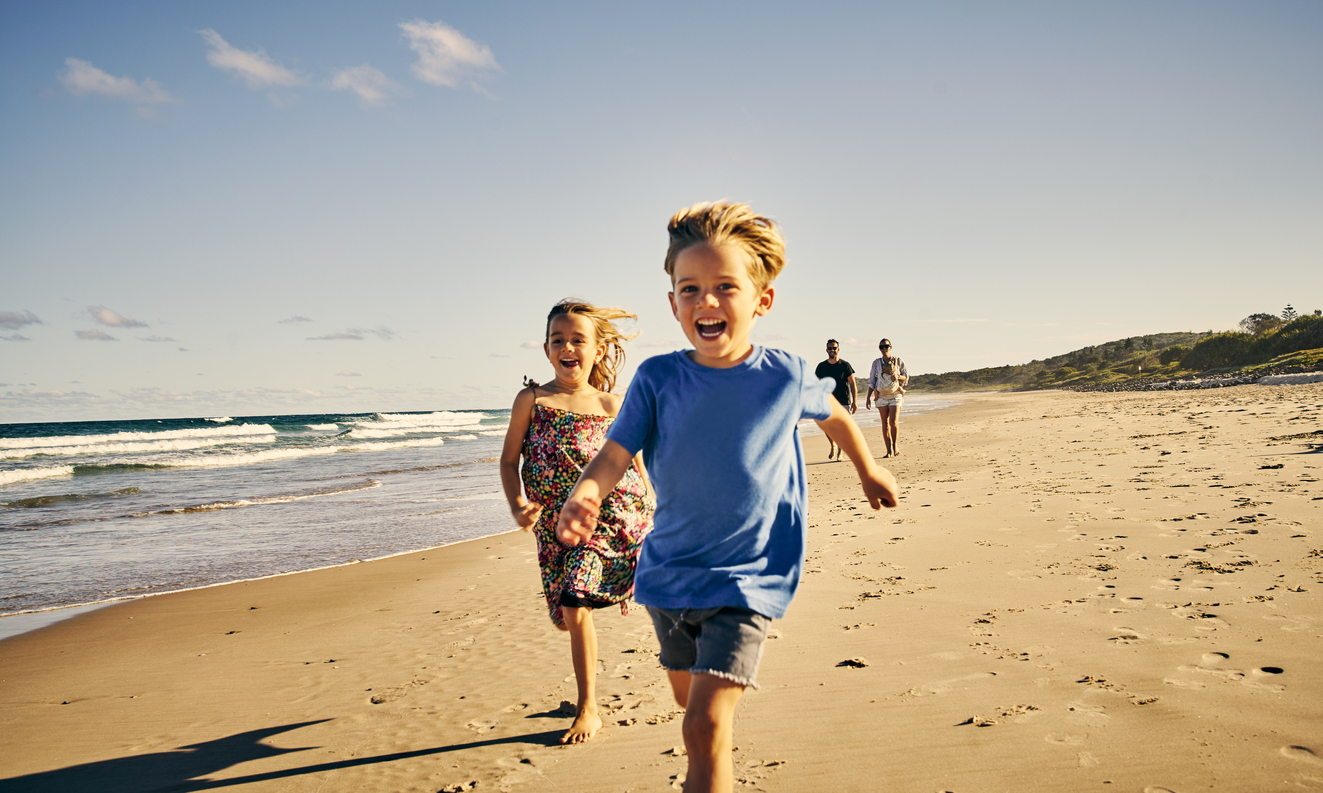
There’s nothing better than a hot summer day at the beautiful beach. Whether you’re visiting a local lake or sandy ocean coastline, stay safe so you can focus on the important thing: relaxation.
At the beach, make sure kids are wearing shoes to avoid getting injured from trash and seashell fragments. Teach kids how to look out for sharks, and explain that while jellyfish may be really cool-looking, they are dangerous and stings are painful. They should be taught to leave all wildlife alone.
Instruct kids to wave their arms over their heads if they are in danger, or tell a lifeguard immediately if they see someone else doing it in the water.
The Red Cross also advises that families be aware of changing weather. Strong winds can come off the ocean without warning, whipping up the waves into dangerous currents. Most beaches have daily wind advisories, typically broadcast through the local news channel, so check the alerts before heading out. Tides also come in predictable patterns</a>; it doesn’t hurt to be aware of the high tide hours, when there is a higher volume of water rushing towards the beach. And again, don’t forget the sunscreen.
7. Zap Those Summer Bugs

Insects are the most annoying part of summer. And they aren’t just a supreme nuisance, they can also bring danger with their buzzing wings.
First and foremost, many people are allergic to insect stings. Bees, wasps, and other members of infraorder Aculeata are a common allergen, and such allergies can trigger life-threatening anaphylaxis.
Unless you get your kids allergy tested, it’s often impossible to know if they are allergic to bee stings until they are actually stung. It’s a good idea to carry a general allergy medication with you on outings. If you know your child is allergic, be sure to carry an Epi-Pen. This is an auto-injecting syringe that contains epinephrine to counteract anaphylactic reactions. Speak with your pediatrician about how to administer the medication, and for kids with such allergies, make sure they know how to give it to themselves and where it is located in the home, at school, in the car and on their person.
Anaphylaxis can cause death in minutes. Call for EMS immediately, and go to the ER even after administering an Epi-Pen. While these medications can save lives, they are not a foolproof antidote against severe allergic reactions and patients can require additional care.
Ticks are another danger. The Centers for Disease Control and Prevention warns that they can transmit a variety of diseases, including ehrlichiosis and Lyme disease. Always check your bodies and your kids’ bodies for tick bites after coming in from outdoors. If you find a tick, don’t panic — use tweezers to gently remove it, ensuring that its head and mouth are removed intact and not left inside the skin. If you notice any rashes at the site of the bite, or a fever develops, see your doctor.
Don't Forget the Pets!

Pets are just as susceptible to harmful insect bites as humans. The AKC notes that dogs can also have allergic reactions to bee stings, and suggests that owners “observe your dog for several hours to make sure that any swelling does not interfere with breathing or swallowing.” If the swelling is causing any of these problems, go see your vet immediately.
Pets can get sick from tick bites, and they also bring ticks indoors. Remove any ticks you find on their skin immediately. For dogs, use a topical tick preventative, like Frontline, and see your vet about further care. Such products are not intended for cats, notes the CDC, so speak to your vet about keeping your kitty safe.




